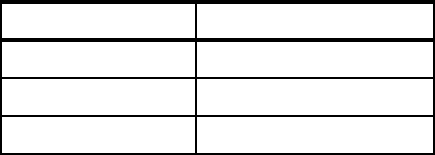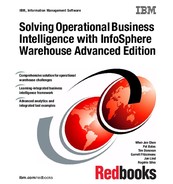
Chapter 4. Data modeling: End to end 129
option menu, select ADD Data Object Existing Levels and then select
the new level MARKET_SEGMENT.
Figure 4-27 shows the edited dimension.
Figure 4-27 Complete edited Customer Profile Dimension
We now have to edit what becomes the final dimension of our cube service.
Currently the GEO_AREA dimension is not seen as a valid dimension and
was not added to our original default cube service. The reason for this is
because in our current model, this dimension does not have any hierarchies
defined. Thus, we have to create a hierarchy within the model that can be
used within the cube service.
Before we can add a new hierarchy, we have to make sure that we have the
right attributes and current levels. Navigate to the GEO_AREA dimension and
investigate the current attributes and levels by selecting these items. View
their properties within the properties window at the bottom of the Design
Studio window. The current attributes do not provide a great deal of
information, so we add a new attribute and level.

130 Solving Operational Business Intelligence with InfoSphere Warehouse Advanced Edition
11.Under the Attributes directory, select Add Attribute from Columns from the
option menu. Within the new panel that appears, open the items until all the
columns within the table are displayed. For our example, we select the
REFER_NUM column and rename it to AREA_REFERENCE.
12.Add a new level with the details shown in Table 4-3.
Table 4-3 Level details for AREA_REFERENCE
13.Select and right-click the Hierarchies directory within the GEO_AREA
dimension to bring up the option menu. Select Add Hierarchy. The newly
created hierarchy at this point is labeled as “Hierarchy”, which can be
renamed to something more meaningful. We named it LOCATION
REFERENCE.
Level name AREA_REFERENCE
Level type Regular
Key attributes GEO_AREA_ID
Default attribute AREA_REFERENCE

Chapter 4. Data modeling: End to end 131
14.Finally, using the same process, we add the existing level
AREA_REFERENCE to this newly created hierarchy. Figure 4-28 shows the
final view.
Figure 4-28 Third dimension being defined within our cube model
We have now finished defining the alterations to our cube model. However, the
definition of the current basic cube service that was also created during the
automatic cube definition does not contain any of the changes that we have
made to our cube model. So, we can either alter the definition of our basic cube
service, or create a new cube definition.
In the Cubes directory of our cube model, we have the definition of the basic
cube service INDIVIDUAL_CST_DYN_FACT. Considering the number of
changes we have made to our new cube model, it will be easier to define a new
132 Solving Operational Business Intelligence with InfoSphere Warehouse Advanced Edition
cube service. This new definition will still be created in the cube folder. Follow
these steps:
1. Right-click the Cubes folder to view the option menu. Select Add Cube, and
give this new definition of a cube service a valid name. In our case, we named
it CUSTOMER_PROFILES. We have now created a framework for our cube
service definition that at present is empty, without any elements.
2. Select and right-click the cube service CUSTOMER_PROFILES to bring up
the option menu. Select Add Data Object Hierarchy. From the panel that
appears, select the CALENDAR_DATE hierarchy, then click Finish.
3. Repeat the same process for the remaining two hierarchies,
LOCATION_REFERENCE and INDIVIDUAL_CST_PROFILE.
4. Now we have to define our fact measures to complete our cube service
definition. We start by renaming the current fact section from “Cube Facts
(Cube)” to “CUSTOMER_DYN_FACT”. Right-click this new label and select
Add Data Object Cube Measures. In the opened panel, select the table
columns that are required for measures. We select the following columns:
– NUM_OF_CST
– NUM_OF_CST_SURVD
– NUM_OF_SURVD_CST_RSP
– NUM_OF_CST_CPLN

Chapter 4. Data modeling: End to end 133
Figure 4-29 shows the completed cube service definition.
Figure 4-29 New defined cube service
Testing a cube service
Before deploying the new cube service to the InfoSphere Warehouse server
application, test the cube service.
You can test the new cube service within Design Studio by following these steps:
1. Right-click the new cube service definition CUSTOMER_PROFILES to bring
up the option menu. Select Browse Members.
2. In the panel, select the data source this cube relates to. In our case, it is
IWHPRD82. Click Finish.
Design Studio then creates an actual cube service from the cube service
definition and starts running this service on the client development platform. In
the bottom section of Design Studio, a new tab appears labelled Metadata View.
This new area displays the new running cube service and all its elements. You
can browse and confirm that this running service provides all the required
information that your reports will require. If it does not, you can continue to re-edit
..................Content has been hidden....................
You can't read the all page of ebook, please click here login for view all page.
